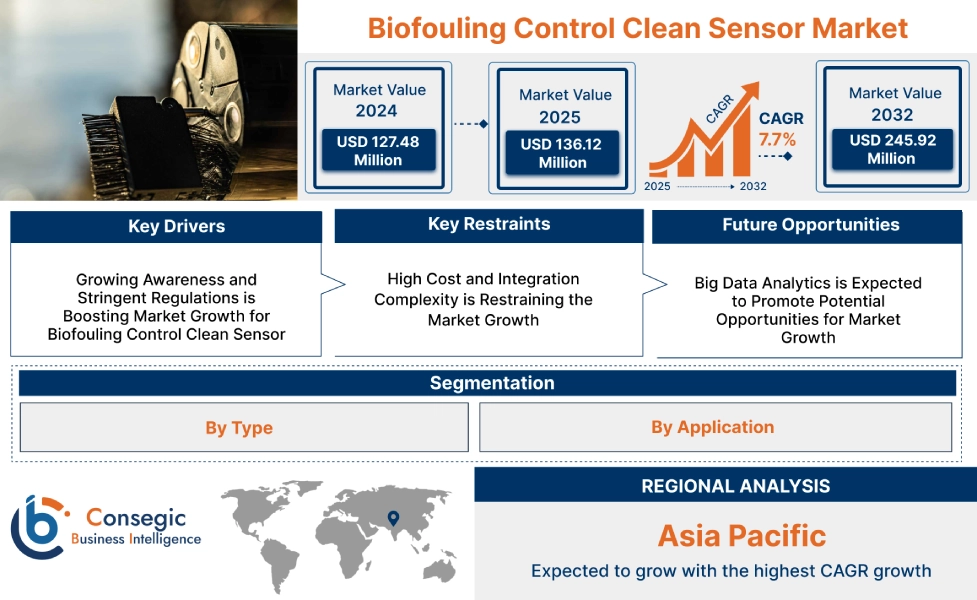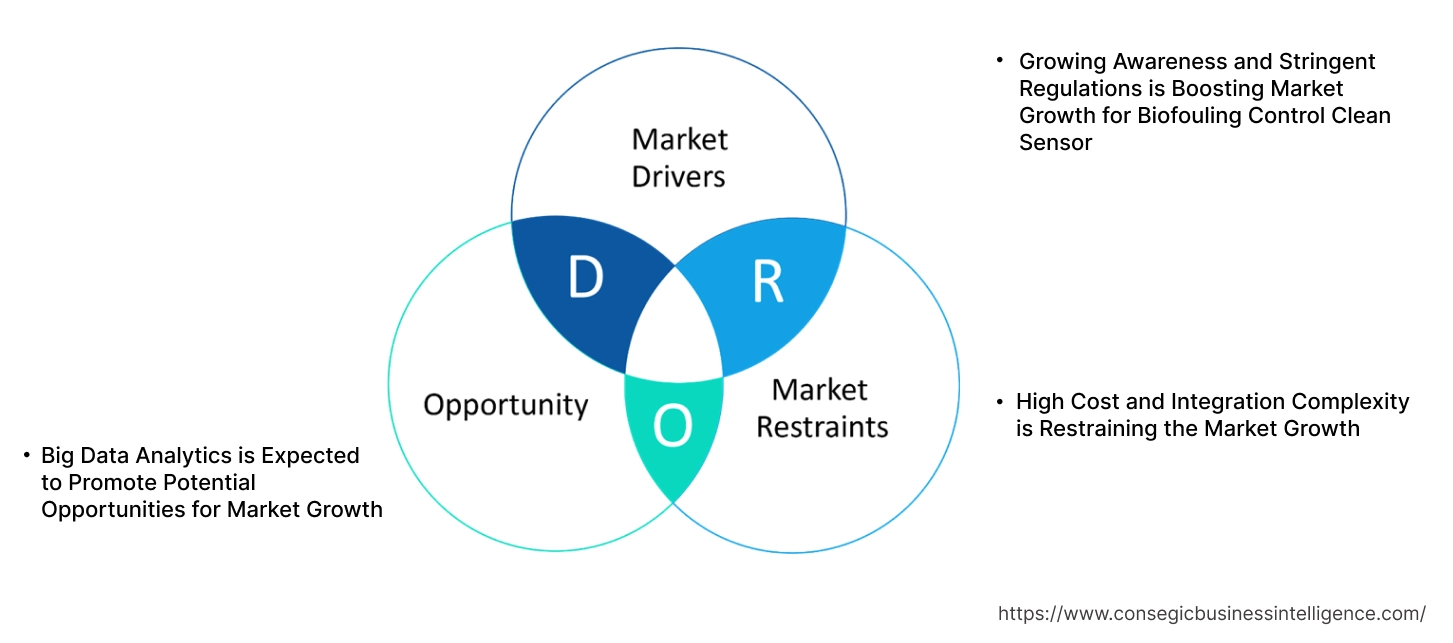Biofouling Control Clean Sensor Market Size:
Biofouling Control Clean Sensor Market size is estimated to reach over USD 245.92 Million by 2032 from a value of USD 127.48 Million in 2024 and is projected to grow by USD 136.12 Million in 2025, growing at a CAGR of 7.7% from 2025 to 2032.
Biofouling Control Clean Sensor Market Scope & Overview:
Biofouling is the accumulation of unwanted microorganisms, such as bacteria and algae, on surfaces, particularly in marine environments. Additionally, the biofouling control clean sensor is a device utilized to prevent or minimize the accumulation of biological organisms on the surface of sensors placed in marine environments. Moreover, the key advantages of sensors include reduced maintenance and cleaning, extended equipment life, real-time monitoring capabilities, and promoting sustainability among others driving the biofouling control clean sensor market demand. Further, biofouling disrupts sensor readings and reduces the accuracy of data transmitted which in turn is driving the biofouling control clean sensor market growth.
How is AI Transforming the Biofouling Control Clean Sensor Market?
AI is influencing the biofouling control clean sensor market by improving detection accuracy, efficiency, and predictive maintenance. Biofouling, which impacts marine vessels, offshore structures, and water systems, requires precise monitoring to prevent damage and efficiency losses. AI-powered sensors analyze real-time data on microbial growth, water quality, and surface conditions, enabling early detection of fouling before it becomes critical. Machine learning algorithms can predict fouling patterns based on environmental conditions, helping operators schedule cleaning more effectively and reduce maintenance costs. Additionally, AI supports automation by integrating sensors with smart control systems for continuous monitoring. This leads to optimized performance, lower energy consumption, and extended equipment life, making AI central to the evolution of biofouling control solutions worldwide.
Biofouling Control Clean Sensor Market Dynamics - (DRO) :
Key Drivers:
Growing Awareness and Stringent Regulations is Boosting Market Growth for Biofouling Control Clean Sensor
The sensors are increasingly needed in industries such as water treatment, offshore, and shipping to mitigate the environmental impact of biofouling and improve operational efficiency is driving the biofouling control clean sensor market demand. Further, the rise in awareness about the negative impacts of biofouling on marine ecosystems is paving the way for market adoption.
- For instance, in April 2025, IMO’s Marine Environment Protection Committee developed a new legally binding framework on biofouling management. The framework is driving technological advancement in biofouling management which in turn is driving the market progress.
Therefore, the growing awareness of biofouling and rising stringent regulations for biofouling management are driving the adoption of sensor technology, in turn proliferating the market demand.
Key Restraints:
High Cost and Integration Complexity is Restraining the Market Growth
The high cost of sensors is a significant obstacle to their widespread adoption, particularly for small and medium-sized businesses which in turn is hindering the biofouling control clean sensor market expansion. Additionally, the initial investment, as well as ongoing maintenance and energy consumption is higher which in turn restricts the market adoption. Further, the complex relationship between sensor performance, fouling mechanisms, and cleaning strategies significantly impacts sensor performance which in turn is hindering the market adoption.
Therefore, the high costs and integration complexity are hindering the biofouling control clean sensor market expansion.
Future Opportunities :
Big Data Analytics is Expected to Promote Potential Opportunities for Market Growth
Big data analytics enhance biofouling control by using data from clean sensors to monitor and optimize cleaning strategies for underwater equipment which in turn is paving the way for biofouling control clean sensor market opportunities. Additionally, big data analytics determine cleaning methods, timing, and location to minimize biofouling and maximize cleaning efficiency which in turn boost the market evolution. Further, the key advantages of adopting big data analytics include reduced cost, improved performance, enhanced safety, and improved efficiency among others.
- For instance, in September 2024, MOL introduced an application called Fouling Analysis which utilizes the capability of big data as well as data collected from sensors in real time for analysis. The analysis helps to significantly reduce unnecessary fuel consumption caused due to biofouling is driving the need for biofouling control clean sensor industry.
Hence, the rising need for integration of sensors with big data analytics is anticipated to increase the utilization which in turn promotes prospects for biofouling control clean sensor market opportunities during the forecast period.
Biofouling Control Clean Sensor Market Segmental Analysis :
By Type:
Based on type, the market is divided into electrochemical fouling control system sensor and stoichiometric fouling control system sensor.
Trends in the Type:
- Rising demand for stoichiometric fouling control system sensor in aquaculture uses sensors to precisely monitor and manage the buildup of organic material on submerged surfaces.
The electrochemical fouling control system sensor segment accounted for the largest revenue share in the biofouling control clean sensor market share in 2024.
- An electrochemical biofouling control system utilizes a sensor, typically an electrode, to detect and control the accumulation of biological material (biofouling) on its surface.
- This sensor measures changes in electrochemical properties that indicate biofouling, allowing for the implementation of control mechanisms to prevent or remove the fouling.
- Biofouling in water systems can reduce the efficiency of filters, membranes, and other treatment equipment. Electrochemical biofouling control systems can help maintain system performance.
- Thus, the market trends analysis shows that the aforementioned factors are boosting the market growth.
The stoichiometric fouling control system sensor segment is expected to register the fastest CAGR during the forecast period.
- A stoichiometric biofouling control system sensor uses a controlled chemical reaction to remove or prevent biofouling, a biological deposit that can impair the performance of water treatment systems.
- This approach relies on the accurate dosing of chemicals based on the measured biofouling levels, ensuring that the reaction is completed efficiently and without excess chemical usage.
- Stoichiometric control ensures that the correct amount of chemicals are used, minimizing waste and potential environmental impact.
- Therefore, the market trends analysis depicts that the aforementioned factors are expected to boost the biofouling control clean sensor market trends in the forecasted period.
By Application:
Based on application, the market is divided into marine engineering, aquaculture, industrial production, and others.
Trends in the Application:
- Rising adoption of biofouling control sensors in in aquaculture to monitor and manage the buildup of marine organisms on submerged surfaces like nets and cages boosting the market demand.
The marine engineering accounted for the largest revenue share of 46.50% in the biofouling control clean sensor market share in 2024.
- Biofouling control clean sensors play a crucial role in marine engineering by enabling the monitoring and control of biofouling, which is the unwanted attachment of organisms to submerged surfaces like ship hulls and underwater equipment.
- These sensors help minimize the negative impacts of biofouling, including increased drag, fuel consumption, and maintenance costs.
- Sensors can be deployed to monitor the growth of biofouling on ship hulls, triggering timely cleaning or applying antifouling treatments to prevent excessive drag and reduce fuel consumption.
- Thus, the market trends analysis shows that the aforementioned factors are boosting the biofouling control clean sensor market growth.
The industrial production segment is expected to register the fastest CAGR during the forecast period.
- Biofouling control clean sensors are devices designed to minimize or prevent the growth of biological organisms on sensor surfaces, particularly in aquatic environments.
- These sensors are crucial for maintaining the accuracy and performance of sensors, reducing maintenance costs, and mitigating environmental impact.
- Biofouling control sensors are used in water treatment plants to maintain the performance of sensors and equipment, such as membrane filtration systems.
- Biofouling impact the performance of industrial bioprocesses, so these sensors are used to monitor and control biofilm formation in these settings.
- Therefore, the market trends analysis depicts that the aforementioned factors are expected to boost the biofouling control clean sensor market trends in the forecasted period.
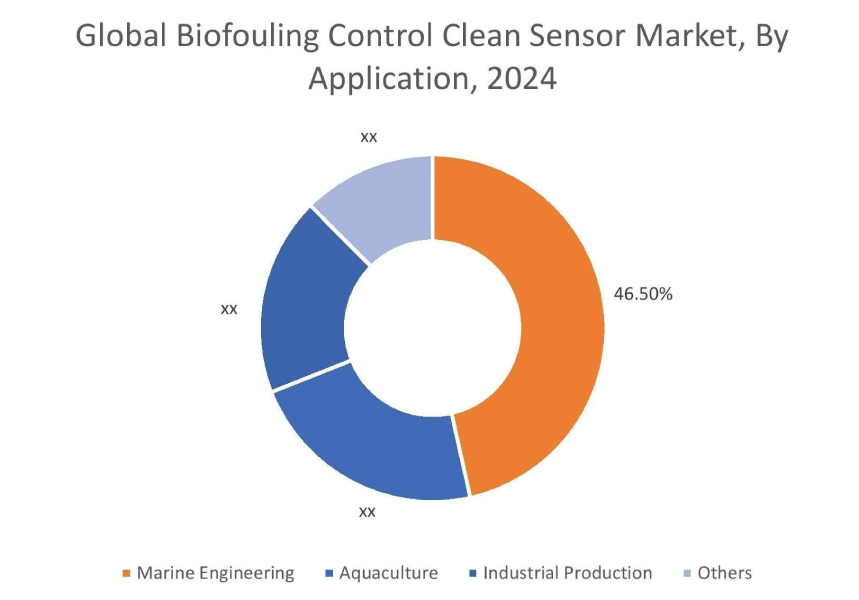
Regional Analysis:
The regions covered are North America, Europe, Asia Pacific, Middle East and Africa, and Latin America.
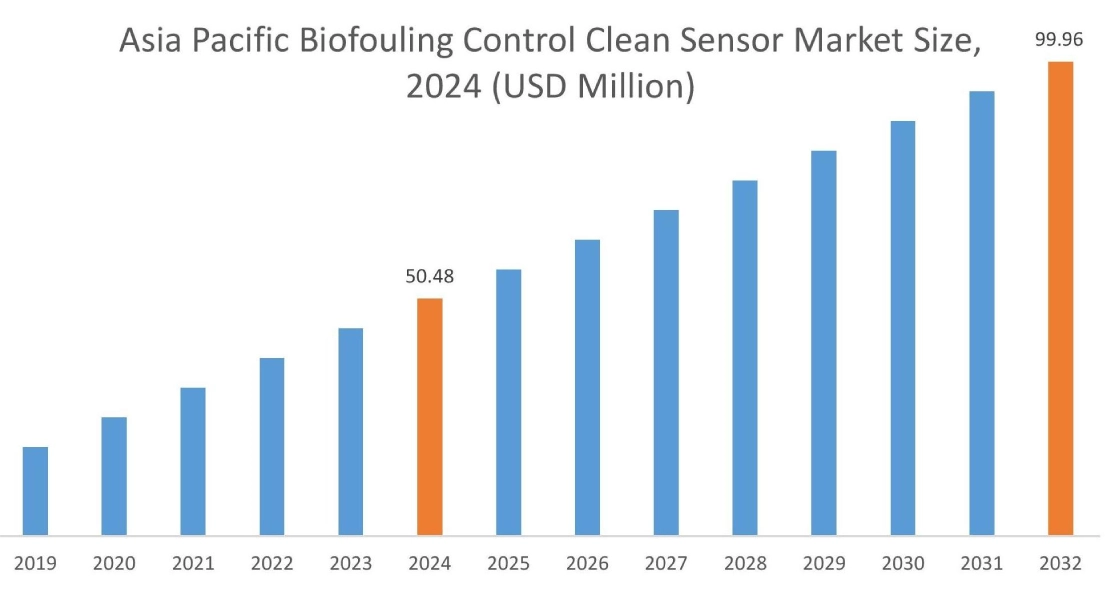
Asia Pacific region was valued at USD 50.48 Million in 2024. Moreover, it is projected to grow by USD 54.02 Million in 2025 and reach over USD 99.96 Million by 2032. Out of this, China accounted for the maximum revenue share of 29.54%. The market is mainly driven by its deployment in water treatment, offshore, shipping, and other industries. Furthermore, factors including stricter environmental regulations and increasing environmental awareness are projected to drive the market growth in Asia Pacific region during the forecast period.
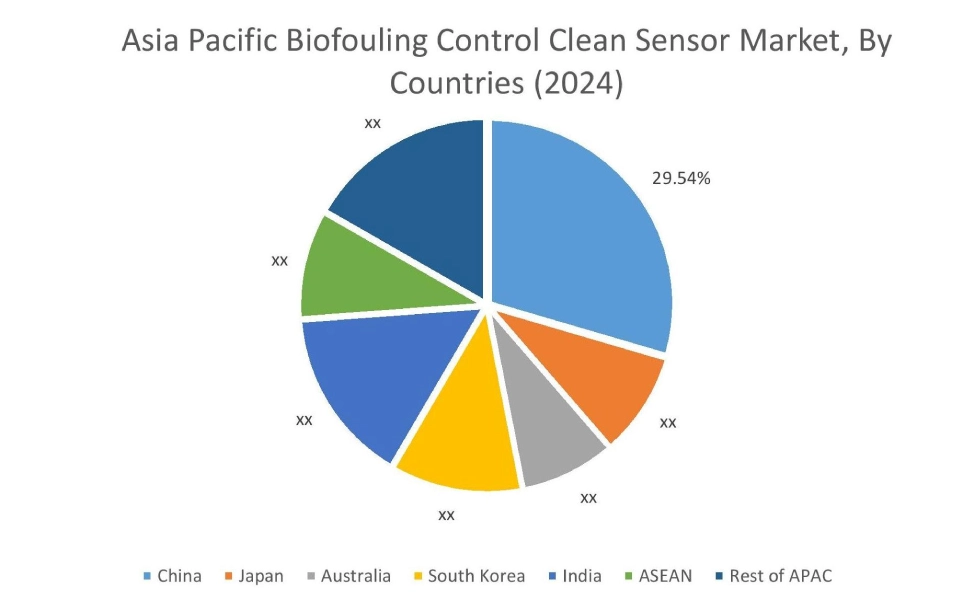
North America is estimated to reach over USD 67.14 Million by 2032 from a value of USD 34.92 Million in 2024 and is projected to grow by USD 37.28 Million in 2025. The North American region's growing adoption of sensors in diverse applications such as underwater research, shipping, and others offer lucrative growth prospects for the market. Additionally, the rising adoption of advanced technology is driving the market development.
The biofouling control clean sensor market analysis depicts that governments imposing stricter regulations on maritime operations is driving the market in Europe. Additionally, the key factor driving the market is increasing water scarcity as well as rising adoption of water treatment and desalination plants is propelling the market adoption in the Middle East and African region. Further, the growing focus on developing new strategies and technologies is paving the way for the progress of the market in the Latin America region.
Top Key Players and Market Share Insights:
The biofouling control clean sensor industry is highly competitive with major players providing solutions and services to the national and international markets. Key players are adopting several strategies in research and development (R&D), product innovation, and end-user launches to hold a strong position in the global biofouling control clean sensor market. Key players in the biofouling control clean sensor industry include -
- ALVIM SRL (Italy)
- ABB Ltd. (Switzerland)
- Sea-Bird Scientific (USA)
- ANB Sensors (UK)
- Aanderaa (Norway)
- AML Oceanographic (Canada)
- RBR Ltd (Canada)
- Hydrolab (USA)
- KROHNE Group (Germany)
Biofouling Control Clean Sensor Market Report Insights :
| Report Attributes | Report Details |
| Study Timeline | 2019-2032 |
| Market Size in 2032 | USD 245.92 Million |
| CAGR (2025-2032) | 7.7% |
| By Type |
|
| By Application |
|
| By Region |
|
| Key Players |
|
| North America | U.S. Canada Mexico |
| Europe | U.K. Germany France Spain Italy Russia Benelux Rest of Europe |
| APAC | China South Korea Japan India Australia ASEAN Rest of Asia-Pacific |
| Middle East and Africa | GCC Turkey South Africa Rest of MEA |
| LATAM | Brazil Argentina Chile Rest of LATAM |
| Report Coverage |
|
Key Questions Answered in the Report
How big is the biofouling control clean sensor market? +
The biofouling control clean sensor market size is estimated to reach over USD 245.92 Million by 2032 from a value of USD 127.48 Million in 2024 and is projected to grow by USD 136.12 Million in 2025, growing at a CAGR of 7.7% from 2025 to 2032.
What are the major segments covered in the biofouling control clean sensor market report? +
The segments covered in the report are type, application, and region.
Which region holds the largest revenue share in 2024 in the biofouling control clean sensor market? +
Asia Pacific holds the largest revenue share in the biofouling control clean sensor market in 2024.
Who are the major key players in the biofouling control clean sensor market? +
The major key players in the market are ALVIM SRL (Italy), ABB Ltd. (Switzerland), AML Oceanographic (Canada), RBR Ltd (Canada), Hydrolab (USA), KROHNE Group (Germany), Sea-Bird Scientific (USA), ANB Sensors (UK), and Aanderaa (Norway).
